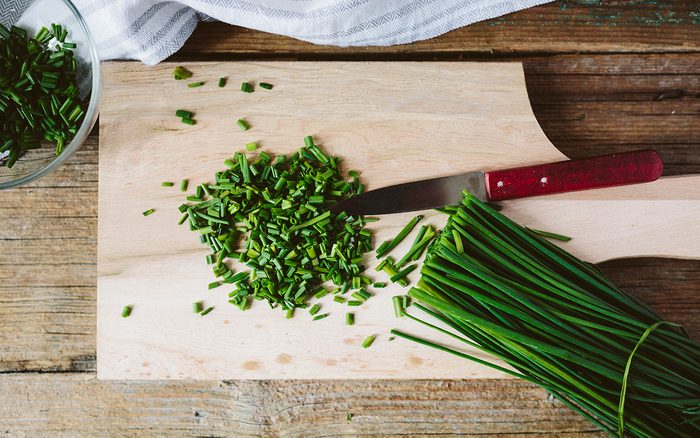Chives: How to Grow, Harvest and Use Chives
Updated: Jun. 30, 2020

If your only experience with chives is buying them at the store, it's time to learn about growing this herb at home.
If you’ve never grown chives before, you’re in for a treat! They are one of the easiest herbs to grow at home, last all season and can be used to garnish and flavor so many dishes.
What Are Chives?
Chives are a relative of onions and leeks, but they’re classified as an herb. Chives have tall, dark green, slender leaves that are hollow inside. The blooms on chive plants are beautiful, pale purple globes made of tiny flower clusters. All parts of the chive plant are edible, though it’s primarily grown for the leaves. Chives have a delicate onion flavor in both the leaves and flowers.
The Difference Between Chives, Scallions and Garlic Chives
Scallions are a different species of allium than chives. They are taller and with larger, lighter green leaves. Some plants that are actually immature onions (green onions) may be referred to as scallions. In either case, these have a much stronger, more intense onion flavor than chives. Here’s how to regrow green onions.
Garlic chives look more similar to true chives—dark green leaves and a grass-like appearance, but again are a different species. The leaves of garlic chives are flat and have a flavor that is more garlicky than oniony.
How to Grow Chives
Not only are chives a cinch to start growing, they’re a perennial herb—meaning they will grow in your garden for years! Chives are hardy to grow in zones 3 through 10. One way to grow chives is to divide an existing plant—ask a neighbor or family member if they’ll dig up a few for you. Or you can start chives from seed. The seeds are tiny, the size and color of poppy seeds. Plant them 1/4-inch deep in well-drained soil. You can plant them to grow in a clump or in a tidy row in your vegetable garden.
Chives are an excellent option for herb container gardening, and you can also plant them in your landscape gardens.
When to Harvest Chives
Chives are ready to harvest once they reach six inches in height. Choose stems that are firm with no browning, and snip them using sharp scissors. The plant will regrow leaves all season long, so harvest them often.
When the purple flowers appear in early summer, you have two options: snip them off right away so the plant’s energy will go into growing leaves, or let the flowers stay until they are dry and faded. At this point they are full of seeds (over 100 seeds per flower head).
Snip them off to prevent the seeds from scattering—you can save the seeds to plant next year.
How to Cook with Fresh Chives
The flavor of chives is delicate, so when using the herb in recipes, add them toward the end of cooking time to preserve the flavor. Use scissors to snip chives into fluffy omelets and creamy mashed potatoes. Chives make a beautiful garnish when scattered over steamed vegetables, fresh salads or summery pasta dishes like pasta primavera. Make an herb butter with chives as a savory accompaniment to corn on the cob or hot biscuits. And of course, chives are delicious blended into cream cheese to spread over homemade bagels.
How to Cook with Chive Flowers
Don’t forget about the chive flowers—they’re edible, too! Gently pull the clusters apart, then scatter the tiny flowers over salads and hors d’oeuvres. Or make chive blossom vinegar: Fill a bottle with just-opened chive blossoms, then fill the bottle with white vinegar. After two weeks, strain the vinegar, and use it for vinaigrettes and to finish cooked dishes. Check out more edible flowering plants.




















